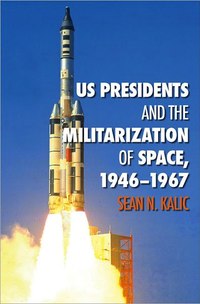Review: US Presidents and the Militarization of Spaceby Jeff Foust
|
| After Sputnik, Kalic argues, President Eisenhower and then-Senator Johnson “realized that the United States could gain political mileage by taking a public position advocating the peaceful use of space.” |
As the title US Presidents and the Militarization of Space, 1946–1967 suggests, Sean Kalic examines the “prehistory” of the Space Age for his analysis of US military space policy, going back to the early RAND Corporation and other post-World War II studies that examined the feasibility and utility of satellites. Even then space was seen as a different domain than the land, sea, and air. At a 1949 meeting at RAND, James Lipp, head of RAND’s missile division, declared that satellites were “qualitatively different from other weapons, as their primary purpose is not to destroy things.” In other words, he saw satellites as primarily an enabler of military activities on Earth, through various applications, and not a weapons system itself.
That approach was adopted by the Eisenhower, Kennedy, and Johnson administrations as the Space Age began in earnest. Space was a place for military activities, but not for warfare itself. After Sputnik, Kalic argues, President Eisenhower and then-Senator Johnson “realized that the United States could gain political mileage by taking a public position advocating the peaceful use of space.” That approach continued even as the US studied development of anti-satellite weapons systems, which they argued were defensive in nature and thus not at odds with a peaceful use of space. It culminated, Kalic concludes, with the Outer Space Treaty of 1967, which “signaled the end of a two-decade quest by the United States to keep space free of weapons.”
Kalic’s thesis is that the US saw the peaceful use of space as being more valuable as both a political selling point as well as a platform for supporting terrestrial military missions than as another battleground. While he makes a strong argument in this respect, one wonders how convincing those arguments would have been if it had turned out to be more technically feasible to station weapons in space, either for use there or on the ground. The RAND studies of the late 1940s, for example, considered satellites as “exo-atmospheric bombing platforms” but concluded they weren’t feasible given the mass of weapons and the limited capabilities of rockets of that era. By the time the Space Age kicked into high gear, the ICBM demonstrated it could hit targets on the other side of the world in half an hour, while a space-based platform might pass over a target just a couple times a day, making it far less useful a weapon. It’s a lot easier to rule out the use of weapons in space when they turn out to be not as compelling as alternative approaches.
Throughout the book, Kalic suggests the US sought to ban weapons from space and achieved this goal with the 1967 Outer Space Treaty (OST). As he states in the conclusion, by 1967 the US had achieved its goal of becoming the world leader in the peaceful use of space “and had negotiated an international treaty that banned weapons from space.” However, the OST only bans the placement of “nuclear weapons or any other kinds of weapons of mass destruction” in space. The treaty does not ban other weapons, like ASATs. For the last several years, Russia and China have pushed for a treaty that would ban all kinds of weapons in outer space. The US has opposed, arguing that it is unverifiable and unnecessary, and has instead supported efforts to develop a “code of conduct” for outer space activities. As both technologies and geopolitics evolves from the bipolar Cold War world of the early Space Age, different political and technical approaches may be needed to maintain space’s unique position of being militarized but not weaponized.
